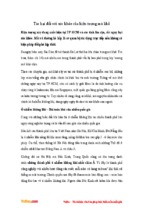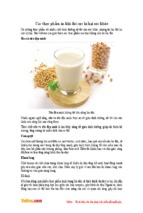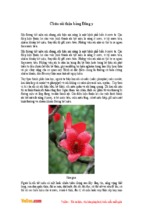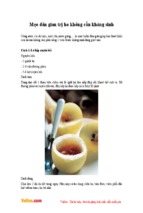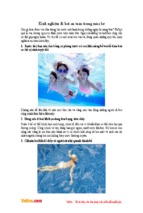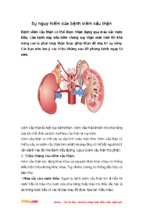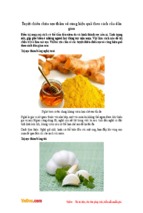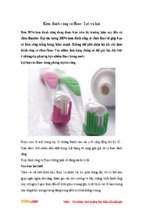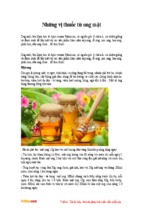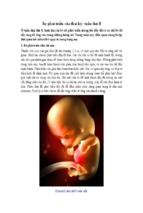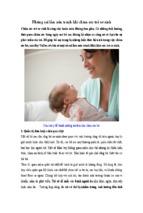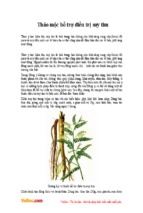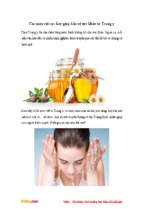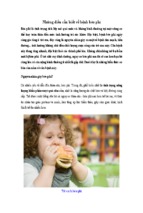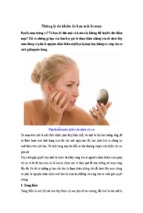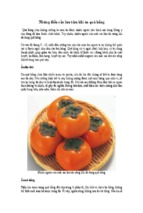UNESCO OFFICE IN DOHA
An Illustrated Checklist
of the Flora of Qatar
John Norton, Sara Abdul Majid, Debbie Allan,
Mohammed Al Safran, Benno Böer & Renee Richer
An Illustrated Checklist
of the Flora of Qatar
John Norton, Sara Abdul Majid, Debbie Allan,
Mohammed Al Safran, Benno Böer & Renee Richer
2009
UNESCO OFFICE IN DOHA
Contents
First published in 2009 by Browndown Publications, Gosport, UK.
ISBN 978-0-9563961-0-5
Text copyright © J.A. Norton, S. Abdul Majid, D.R. Allan, M. Al Safran, B. Böer & R. Richer, 2009.
Photographs copyright © J.A. Norton, except Plates 45 & 66 © S. Abdul Majid; 3, 17, 19, 20 & 109
© S.J. Aspinall; 1, 4, 8, 11, 14, 28, 31, 32, 34, 35, 37, 40, 46, 51, 65, 67, 69 & 77 © R. Richer; 2, 64
& 74 © M. Al Safran.
Authors
ii
Foreword
iii
Preface
iv
Acknowledgements
v
Introduction
vi
Selection of Species
vi
Sources of Information
vi
Overview of Habitats and Vegetation
vii
Notes on Layout and Terminology
Map of the State of Qatar
SPECIES ACCOUNTS
x
xiv
1-84
Pteridophyta
1
All rights reserved. No part of this publication may be reproduced without prior permission of the
publisher.
Gymnospermae
1
Angiospermae: Dicotyledoneae
1
The designations employed and the presentation of the material throughout this publication do not
imply the expression of any opinion whatsoever on the part of UNESCO concerning legal status of
any country, territory, city or area of its authorities, or concerning the delimitation of its frontiers
or boundaries. The views expressed in this publication are those of the respective authors and do
not necessarily reflect the views of UNESCO.
Angiospermae: Monocotyledoneae
69
References and Bibliography
85
Internet Resources
88
The production of this book was generously supported by UNESCO Doha, Maersk Oil Qatar and
Qatar Foundation.
Index to Families and Species
89
The authors would be pleased to receive comments or corrections on the text, further information
on the occurrence of species in Qatar and good quality digital photographs of plants growing in
Qatar. Correspondence should be addressed to: John Norton, Browndown Publications, 215 Forton
Road, Gosport, Hampshire PO12 3HB, UK (e-mail:
[email protected])
Printed by Ashford Colour Press Ltd, Gosport, UK.
Cover photograph: a sandy wadi with Acacia tortilis and Lycium shawii, within an area of gently undulating
limestone ‘hamada’ – the characteristic landscape of Qatar (south-west Qatar, March 2007). Insets: Convolvulus
cephalodpodus, Anastatica hierochuntica, Centaurea sinaica and Cynomorium coccineum.
Authors
Foreword
John Norton is an independent ecological consultant and botanist, based in Hampshire, UK.
He has spent more than two and a half years in total working in the Arabian Peninsula, including
spells in northern Saudi Arabia and the United Arab Emirates to conduct research on the Houbara
Bustard. Since 1998 he has made several trips to Qatar to undertake wildlife surveys and impact
assessments, including a detailed survey of the Dukhan area in 2007. He has a keen interest in the
wildlife and ecology of desert habitats and has built up an extensive collection of photographs and
herbarium specimens. In the UK he is a committee member of the Hampshire Flora Group, which
organises field meetings, and encourage people to develop botanical identification skills.
This illustrated plant species Checklist of the Flora of Qatar has been produced in the
overall framework of a major project linking biodiversity conservation with cultural
heritage, namely the Quranic Botanic Garden (QBG) in Qatar. The guidelines for the QBG
have been developed under the guidance of Qatar Foundation and with the international
and inter-disciplinary support and expert advice of Mr. Abdulaziz Al Midfa (United Arab
Emirates), Prof. Dr. Abdulrahman Al Muftah (Qatar), Prof. Dr. Kamal Batanouny (Qatar
Foundation), Dr. Benno Böer (UNESCO), Dr. Gary Brown (Kuwait), Dr. Uwe Herpin
(Brazil), Prof. Dr. Fareed Krupp (Germany), Dr. Guido Licciardi (UNESCO) and Ms.
Narjes Yedder (Tunisia). They have developed the over-arching vision to ‘Provide the people
of Qatar and the Gulf Region with a Centre of Excellence for Research and Education, promoting
the conservation of natural and cultural heritage, emphasising the teachings of the Holy Qur’an and
the Hadith. This will also function as a prime recreational destination’. I am highly thankful to
the above experts.
Benno Böer is a botanist and ecologist working at the UNESCO Doha Office as the Ecological
Sciences Advisor for the Arab Region. He has been involved in several international research
programmes in ecosystem study, vegetation mapping and other forms of botanical research in
Saudi Arabia, Qatar, Bahrain, Oman, Kuwait and the United Arab Emirates and has authored
or contributed to several scientific publications and books including the two most recent floras
covering the UAE (Jongbloed, et al. 2000, 2003). He has a special interest in the rehabilitation of
coastal and desert ecosystems and through UNESCO helped to set up the first biosphere reserve
for the country at Al Reem in 2007 and is helping to establish the Quranic Botanic Garden in Doha.
Sara Abdul Majid is an environmental scientist and dedicated conservationist. Born and raised in
Qatar, she has developed a passion for the unique desert environment of the country. She worked at
an environmental consulting firm (URS Doha office) before pursuing her Masters in Conservation
at University College London. During her time with URS, Sara has been involved in conducting
terrestrial and marine field surveys including the study of baseline flora, fauna, soil/sediment and
groundwater conditions. She has recently conducted research at Al Reem Biosphere Reserve,
including the characterization and mapping of vegetation communities, in collaboration with
UNESCO and the Ministry of Environment (Qatar).
Debbie Allan is a self-taught botanist and naturalist who has studied the flora of her local area of
Gosport in Hampshire for more than 15 years. Together with John Norton she is working on a
flora of the area, which lies on a floristically rich coastal peninsula, to be published in 2010. Past
work has included five years spent indexing scientific publications and 15 months (to April 2006)
computerising botanical records for the Hampshire Rare Plant Register, a project funded by the
Botanical Society of the British Isles and the Hampshire Wildlife Trust. She presently works as an
assistant ecologist with John Norton.
Mohammed Al Safran was born in Qatar and has developed a special interest in its flora and plant
ecology. He studied at Qatar University and subsequently obtained a Masters degree in Agricultural
and Environmental Sciences at Newcastle University in 2008 and is presently completing his
PhD on the ecology and status of Prosopis cineraria and Acacia tortilis in Qatar. He is also currently
teaching at Qatar University Department of Biology & Environmental Sciences and is supervising
the management of the ‘Biology Field’ at the university campus, helping to involve students in the
study of flora, fauna and soil relationships.
Renee Richer is visiting assistant professor at Weill Cornell Medical College in Qatar. Trained as a
botanist and ecologist at Harvard University, she worked in southern Africa from 1994-2002. While
assistant professor and director of the Environmental Conservation and Research Center at the
American University of Armenia, she worked closely with government, NGOs and communities in
furthering environmental development in the country, culminating in the Whitley award in 2007.
With a keen interest in environmental science and sustainable development in arid regions, she
has authored scientific publications and co-authored a book on environmental course design. She
is currently studying the flora of Qatar.
ii
A lot has been achieved in a short time, since October 2007, when UNESCO and Qatar
Foundation embarked on this joint initiative, which received generous support from
Maersk Oil Qatar, and which was assisted by Ralf Oliver of London and Botanic Gardens
Conservation International. The International Advisory Committee met, guidelines were
developed based on expert recommendations, the master plan was developed, reviewed,
revised and produced, and an external evaluation report was compiled. These were all
essential steps towards the establishment of the Quranic Botanic Garden.
The flora of Qatar and the Arabian Peninsula has always been important for the Arab
people, as a source for livestock grazing, construction material, firewood and food. It is
important in our modern times that we study the natural vegetation, learn to understand
vegetation ecology, and document and conserve our national and regional flora. The
indigenous plants have undoubtedly a large number of medicinal, pharmaceutical,
landscaping, scientific and economic values that are yet to be discovered. This volume is a
new and essential contribution, because and it contains a comprehensive listing of species
that occur in the country, as well as providing important eco-geographical information
about these species.
It is with great joy that I can witness and provide the foreword for this milestone as a
supporting element of the QBG. During their research the authors faced many deficits in
the existing literature, namely a lack of reliable, accurate and up-to-date botanical data.
I congratulate them for their achievement, including those elements of real capacity
building. I highly recommend this volume as an important source of information about,
and education into, the understanding of the flora of Qatar.
Saif Al Hajari
Vice-Chairperson of Qatar Foundation
iii
Preface
My interest in Arabian plant life started in 1988 when I travelled to the Harrat al Harrah area in
north-west Saudi Arabia on the first of five trips over a period of two years to study the habitat of
the Houbara Bustard, a traditional quarry of the Arab falconer. Although a dry, rocky area, the
flora here is relatively rich, especially in the sandy wadis and silt pans which retain some moisture
during the summer months. My work then took me to Abu Dhabi during the winter of 1991–92,
where although working as an ornithologist I visited all parts of the Emirate and quickly became
familiar with the range of plant life of this predominantly sandy area. Travels to the Al Liwa oasis,
at the edge of the Empty Quarter, were particularly memorable during this time.
In November 1994 I returned to Abu Dhabi to work for six months for one of the predecessors of
the Abu Dhabi Environment Agency (EAD), where I carried out both bird and plant-related work.
This is where I first met Benno Böer, who had already been employed as an ecologist there for
several years – having previously spent time in the Eastern Province of Saudi Arabia as well as Abu
Dhabi, studying the ecology of mangroves, saltmarshes and desert vegetation. During the spring of
1995 a good rainy spell allowed us the opportunity to study the germination and development of
native desert plants, particularly in the confines of our research station at Sweihan, a 1.5 km x 1.5 km
square enclosure (Böer & Norton 1996a, 1996b). Whilst the flora inside the station flourished, the
plants outside soon disappeared due to the attentions of the local herd of camels. Encouragingly,
we also noticed that parts of an adjacent area had been fenced off to prevent grazing. This may
have been a measure to protect the wintering grounds of the Houbara, or could have been a now
rare example of the traditional Bedouin hema system of grazing protection.
From this background, we subsequently both went on to develop a keen interest in the habitats and
flora of the region and of Qatar in particular. After publishing an important account of his Abu
Dhabi work on the anthropogenic impacts on desert ecosystems (Böer 1999), Benno moved to Doha
to work for UNESCO, where he has gone on to promote the restoration and wise management of
desert habitats. Since 2002 he has been working to set up the first biosphere reserve for the country
at Al Reem, which was finally established in 2007. He was also instrumental in establishing the
Quranic Botanic Garden in Doha.
I carried on working in the UK as an ecological consultant, but in 1998, 2003 and 2004 I made
brief visits to Qatar to carry out ecological surveys for environmental impact assessments at the
two main industrial ‘cities’ of Mesaieed and Ras Laffan. More recently, during February and March
2007 I organised a large-scale flora and fauna survey of Qatar Petroleum’s Dukhan Concession
Area, on the west coast. This followed the wettest winter for 10 years in the Gulf, which resulted
in remarkable green swathes of annual vegetation across large parts of Qatar. I was joined on this
survey by Simon Aspinall, an old friend and then long-term former resident of Abu Dhabi, who
besides being a renowned ornithologist is also one of the most experienced botanists working in
the region. He has contributed several of the photographs included in this book and made more
than his fair share of noteworthy discoveries.
The flora of the Arabian Peninsula has principally been studied and documented by visiting or
expatriate Egyptian, Pakistani, Sudanese and western botanists, most notably Abdel Bari, Boulos,
Batanouny, Chaudhary, Collenette, Jongbloed and Mandaville. Although some of these have
investigated the flora in a professional role through specific research programmes, others have
pursued their studies in their own time in an amateur capacity, particularly the Western botanists.
In Qatar, most of the research has been carried out through the University of Qatar, which was
founded in 1977. Professor Batanouny published the first and only definitive account of the flora
in his Ecology and Flora of Qatar soon after in 1981. This was followed by a short, but useful account
of the flora by El Amin in Wild Plants of Qatar, published by the Arab Organization for Agricultural
Development in 1983, the result of a 14-month collecting trip. No further comprehensive works
iv
on the flora of Qatar have been published since this time, apart from a few journal papers dealing
largely with saline habitats and a detailed report by the University on vegetation types and soil
relationships (Abulfatih et al. 2001).
Unfortunately, the scientific value of the books by Batanouny and El Amin is now diminishing
because plant names have changed and new species have been discovered. The flora has changed
in many areas due to increased grazing pressure, the recreational use of desert areas and particularly
through the increase in irrigation schemes in farms, towns and cities. Benno and I realised that a
new flora of Qatar was urgently needed, but despite our reasonable familiarity with the country we
also knew that neither of us had enough knowledge to be able to write a full scientific flora. This will
hopefully follow in a few years time after we (or others) have carried out more detailed research and
have visited some of the lesser-explored areas. In the meantime, we have compiled this checklist
with the intention of providing an up-to-date scientific list of the plants that are known to occur,
including brief details where known of their status, distribution, habitat and uses.
We were lucky to have found two local Qataris, Sara Abdul Majid and Mohammed Al Safran, both
with a keen interest in the country’s natural heritage, to assist us in compiling this book. Renee
Richer who is currently resident in Qatar also provided useful information on the distribution
of species and medicinal uses. The remaining author, Debbie Allan, shared with me much of the
general research and compilation of information from other floras. Whilst the checklist is not
intended to be an identification guide and does not contain any keys or detailed descriptions, we
hope that it will provide a useful source of information for ecologists and other scientists carrying
out surveys and other research. However, our main aim in publishing it is to stimulate interest and
understanding of the natural habitats, vegetation and flora of Qatar, which in contrast to the rest
of the Gulf states have been poorly studied and under-valued.
The production of the checklist has been kindly funded by UNESCO and will be used to promote
and inform their Quranic Botanic Gardens project, being run in conjunction with the Qatar
Foundation and supported by Maersk Oil Qatar. The aims of the project include the establishment
of a living collection of all native plant species occurring in the State of Qatar, as well as plants from
the Arabian Peninsula and those mentioned in the Holy Quran and the Hadith. It also aims to
build up a knowledge-base of plant taxonomy and vegetation ecology amongst Qatari botanists. In
this regard we have great hopes that young Qatari men and women will discover the beauty of the
national flora, develop a passion for wildlife and come to understand the importance of botanical
and ecological scientific research into the natural world.
John Norton
Gosport, UK, October 2009
Acknowledgements
The authors would like to thank Her Highness Sheikha Mozah bint Nasser al Misned, UNESCO
Special Envoy for Higher and Basic Education for commitment towards botanical education in
Qatar. We also express our thanks to Dr Saif Al Hajiri, Vice-Chairperson of Qatar Foundation
for his interest. Furthermore, we sincerely thank Jacob Thomasen, Saad Al Mohammadi, Peter
Christensen and Maersk Oil Qatar for their support, making this publication possible. We also
express our thanks to UNESCO Representative in the Arab States of the Gulf and Director of the
Doha Office, Dr Hamed Al-Hammami, and all of his staff, for their support.
We are also indebted to Eric Clement (Gosport, UK) for providing advice and help on identification
and taxonomic issues, for proof-reading the text and making many useful suggestions, and also for
checking plant specimens and for the extended loan of books on the Arabian flora. Thanks are also
due to Simon Aspinall (Norfolk, UK) for permission to reproduce photographs.
v
Introduction
Selection of Species
This publication lists all species of vascular plants (flowering plants and ferns) recorded growing
in the wild in the State of Qatar. These comprise all species known to be native, but also many that
have been introduced intentionally or accidentally by man and are now naturalised, often as weeds
of cultivation. Several commonly-planted species are also included that are not yet known to be
widely naturalised, but could become so in the future. They include a few salt-tolerant trees and
shrubs that are becoming increasingly important for urban landscaping and ornamental use in
the Gulf. Such species are widely planted to provide shelter from wind and sun, visual screening of
industrial buildings and for their general aesthetic value in ‘greening’ projects. The total number
of species included in the checklist is nearly 400 of which about 270 are likely to be truly native.
Naturalised species are of interest to botanists and ecologists as they often become established very
quickly when introduced into suitable habitats in places away from their country of origin. Thus
in some cases they may compete with native species for water and other resources. It is important
in publications such as this to document these species and publicise their presence so that their
status can be monitored. In Qatar and elsewhere in the Gulf one tree in particular, the Mesquite
Prosopis juliflora, originally from central America, has now become an undesirable invasive species.
Although primarily found in and around inhabited areas, it is increasingly seen growing in more
remote desert localities. In contrast, the native Prosopis cineraria or ghaf, which is on the edge of
its range in Qatar, is undergoing a serious decline. The vast majority of the naturalised species
included in this checklist are annual or perennial ‘mesophytic’ plants that are dependent on
artificial irrigation. Many, however are also found in the numerous natural depressions in Qatar,
particularly after winter rains, when soils may remain damp for a considerable time. It is prudent
to monitor such species to see if they are having any impact on the native flora, which also abound
in these depressions.
Batanouny and El Amin visited cultivated areas as part of their research and so recorded these
naturalised and ‘escaped’ species in some detail. Regrettably, the present authors have not been
able to revisit many farm areas; instead we have concentrated out efforts on natural habitats. We
have therefore not been able to confirm the current status of many of the species mentioned in
the earlier publications. Several species recorded in Qatar have not been fully confirmed through
expert determination of specimens. The two published volumes of the Flora of the Arabian
Peninsula and Socotra (Miller & Cope 1996, Cope 2007) only list species as occurring in Qatar (and
other countries) where the authors have seen specimens. In this checklist unconfirmed species have
been noted in the text and include, for example, those recorded by El Amin but not previously by
Batanouny, and a few old records by Obeid (1975). Where the identification is thought very likely
to have been in error the species name has been shown in square brackets.
Sources of Information
This checklist is partly a synthesis of historically published information, especially from the previous
accounts of the Qatar flora by Batanouny (1981) and El Amin (1983), as already mentioned. It was
felt important to summarise the information included by these authors, as their works include much
useful data on status, distribution and uses of species. More recent information was obtained from
a list of newly recorded species for Qatar published by Abdel Bari (1997). Other principal sources
include the aforementioned Miller & Cope 1996 and Cope 2007, along with Boulos’s Flora of Egypt
(Boulos 1999-2005), Jongbloed’s Wild Flowers of the UAE (Jongbloed et al. 2003) and Mandaville’s
Flora of Eastern Saudi Arabia (1990). Other recent floras covering Gulf states were also consulted,
including those for Bahrain: Phillips (1988) and Cornes & Cornes (1989) and for Kuwait: Daoud
& Al-Rawi (1985) and Shuaib (1995). Specific comments made by these authors have been cited in
the text, but to save space the dates of publication have not usually been repeated.
vi
Much information for this checklist has, however, been derived from the authors’ knowledge
and experience of the flora both in Qatar and other parts of the Arabian Gulf. Nonetheless, the
occurrence and distribution of many species over much of Qatar is poorly known and so some of
our remarks are either brief or generalised. Further research and a mapping survey of the whole
country is badly needed. The least explored parts of the state include the extreme north coast, the
southern borderlands with Saudi Arabia and the offshore islands that lie within Qatari territory. It
is probable that such areas could support a number of hitherto unrecorded native species. It is also
likely that a large number of non-native species will be added to the list in future years as more are
introduced through importation of food, forestry plants and livestock. Furthermore, little is known
about the species of permanently wet areas, such as ponds and lagoons created through irrigation
run-off and water treatment schemes.
Photographs and line-drawings are a valuable means of checking the identity of plant species, so
in addition to providing a selection of our own photographs in this checklist, we have also carefully
referenced published photographs and illustrations from the floras and other guides covering the
Gulf region. In addition to those mentioned above, these comprise Western (1989) and the two most
recent publications covering the Sultanate of Oman (Ghazanfar 2003, Pickering & Patzelt 2008),
which contain a small but useful selection of plants found in Qatar.
Much of the time spent compiling the checklist was taken up with checking taxonomy and recent
changes to nomenclature. Names of plants unfortunately change constantly as new information
from field-work or herbarium research is published, particularly now that DNA studies are widely
carried out. We have tried to use the most up to date name available, if we believe the change has
been or will be accepted by the scientific community. In some cases the use of a scientific name of
a plant species comes down to personal choice. Therefore we have largely followed Miller & Cope
(1996), Cope (2007), Jongbloed et al. (2003) and Boulos (1999-2005); but have also made use of
internet resources such as ePIC (electronic Plant Information Centre administered by the Royal
Botanic Gardens, Kew), IPNI (International Plant Names Index), GRIN (Germplasm Resources
Information Network, United States Department of Agriculture) and for Asteraceae and some
other plants the Euro+Med PlantBase. Commonly-used synonyms have been given for each species
where relevant and any taxonomic uncertainties have been noted in the species accounts.
Arabic names have been compiled from first-hand knowledge of the authors, partially supplemented
by literature searches. Names have been listed where well known in Qatar or in widespread use in
the Gulf or other parts of the Arab-speaking world. Most the publications listed above also have
useful lists of Arabic names, but Mandaville (1990) is recommended as he gives the sources of most
of his names and provides a comprehensive Arabic index.
Overview of Habitats and Vegetation
Qatar is largely an arid, desert area with a hot, sunny climate, receiving minimal rainfall, which is
often sporadic in occurrence. Fogs occur in winter and spring and contribute a more regular source
of water to the flora. The majority of the land surface consists of flat to gently undulating calcareous
rocks, with sand formations occurring in the south-east. The country is largely low-lying, but there
are some small jebels in the south (rising to just over 100 metres at the highest point) and a rocky
Miocene ridge extending from Dukhan to near the southern border on the west coast. Away from
the deeper sand areas, the soils are generally shallow, consisting of sands, silts and gravels, but the
north of the country also supports numerous natural depressions known as ‘rodat’, of various sizes,
many of which have much deeper, richer soils, and have therefore been converted to farmland to
grow crops. The reader is recommended to refer to Batanouny (1983) and Abulfatih et al. (2001)
for further information on geology, soils and climate.
From a plant ecologist’s point of view the main edaphic (soil) factors affecting choice of habitat
of desert species in areas such as the Gulf are the degree of retention of soil moisture, the level
vii
of salinity, soil particle size and the degree of soil compaction. These are often inter-related. The
mineral and nutrient content of soils may be important secondary factors affecting plant growth
in some areas. Thus, the flora of Qatar can usually be placed into one of five main habitat groups:
(a) strongly ‘xerophytic’ species of rock and gravel deserts where soil depth is limited and
conditions are very dry;
(b) ‘halophytic’ species tolerant of saline areas, such as saltmarshes, coastal sands, sabkha edge
and inland oolitic sands;
(c) species that grow in natural silt and sand depressions where water retention is higher than
for (a);
(d) species adapted to grow in deeper sand, where water is available under the surface;
(e) species associated with man-made and man-influenced sites, particularly those receiving
artificial irrigation, such as roadsides, farms, gardens and sewage ponds.
Species that are more catholic in their requirements may be found in more than one group.
Annual species mainly fall in groups (a), (c) and (e) and can grow in almost any situation or soil
type, provided there is at least a shallow surface covering of sand or silt. Group (e) includes many
naturalised species that are weeds of cultivation. However, a number of true desert species also grow
in irrigated habitats; often more luxuriantly due to the increased supply of water. Some of these are
adapted to spread quickly in times of good rainfall.
The main habitat types and associated vegetation in Qatar can be summarised as follows:
Dunes and deep sand areas are strongly undulating or form chains of the familiar crescentshaped ‘barchan’ dunes; they occur mainly in the south and south-east and are moderately saline,
characteristically supporting the mound-forming shrub Seidlitzia rosmarinus.
Sand sheets are shallower areas of sand forming flat or gently undulating terrain; they may be
stabilised and firm, or sometimes quite soft. They occur mainly in the south-west and are often
dominated by sand-binding grasses, especially Panicum turgidum, or locally by the shrum Haloxylon
salicornicum.
White sand of marine origin occurs inland in SW Qatar. It is moderately saline and supports a
distinctive vegetation dominated by Cyperus conglomeratus and Tetraena qatarensis. Agriophyllum minus
is a distinctive associate.
Coastal sand on beaches is usually coarse-textured and calcareous due to abundant shell fragments.
It is often grey, or sometimes pinkish in hue. Halophytic shrubs such as Cornulaca spp. usually
dominate, but the habitat often supports diverse mixed grass and shrub vegetation. Naturalised
date palms (Phoenix dactylifera) occur in this habitat at Umm Bab.
Wadis and runnels are linear features formed in the landscape, which may flow with water during
times of heavy rainfall. In Qatar they are generally not well defined in terms of depth or gradient, but
are characterised by linear or oval patches of accumulated sand, often within otherwise featureless
hamada or gravel desert areas. They support distinctive types of vegetation, composed of certain
grasses, perennial and annual herbs and also often support stands of Lycium shawii. The lily Dipcadi
erythraeum is especially characteristic of small sandy runnels.
Sand and silt pans and larger natural depressions (‘rodat’) support moderately compact to
very compact soils composed of fine sand, silt or loam. They often become flooded during rains
and may retain moisture for some time afterwards. Soils often have higher quantity of organic
matter than other desert areas. They are usually characterised by stands of trees and shrubs
viii
comprising Acacia spp., Prosopis juliflora, Ziziphus nummularia and Lycium shawii; and are often rich
in annual and perennial herbs and grasses. Characteristic species of silt pans include Cymbopogon
commutatus, Pulicaria undulata, Andrachne telephioides, Astragalus eremophilus, Althaea ludwigii and
Corchorus depressus. In the south, depressions are mostly small, circular features a few metres to a
few hundred metres across, but in the north and central parts of Qatar they may be irregular or
more linear in shape and can reach 2-3 kilometres in length. These larger rodat have often been
converted to farmland and are irrigated and cultivated to grow crops. For further information see
Batanouny (1981) and Babikir (1986).
‘Sabkha’ refers to usually low-lying areas of sandy desert which have been inundated by seawater
or rainwater that has dried out leaving a salt-encrusted surface. They occur mainly on or near the
coast in Qatar, with larger ones occurring east of Dukhan and at Mesaieed. Most are too salty to
support any vegetation, but many have a marginal zone (referred to as ‘sabkha edge’) that is often
dominated by halophytic species such as Limonium axillare, Salsola spp. or Tetraena qatarensis. Native
species of Tamarix may also occur.
Saltmarsh occurs in coastal bays and creeks, often in muddy areas, and is locally dominated by
mangrove Avicennia marina, with dense stands of Arthrocnemum macrostachyum and other halophytes.
Gypsum desert occurs in the west and north-west, particularly in the Dukhan area. Soils are
composed of a high proportion of calcium carbonate and are strongly calcareous. They vary from
soft to moderately compact and are also mixed with sand and silt in places. They support a variety
of vegetation types that also occur in other sandy and gravelly habitats, but a few species such as
Helianthemum kahiricum and Erodium glaucophyllum are particularly characteristic.
Gravel plain is used to describe flat desert areas with a surface layer of gravel or stones. Several
variations of this habitat occur in Qatar, with soils varying from soft to compact and fine to coarsetextured. Most of these are characterised by relatively poor cover of vegetation, often of lowgrowing or stunted perennial herbs, grasses and shrubs. Typical species include Helianthemum lippii,
Polycarpaea repens and Stipagrostis spp.
‘Hamada’ is flat or gently undulating desert with stones and rocks on the surface or embedded in
the surface, usually with compact soils and only small quantities of wind-blown sand and silt on the
surface. In Qatar this habitat is formed from the limestone bedrock and is a feature of large areas
of the interior of the country. The vegetation is usually dominated by Lycium shawii and Tetraena
qatarensis, with the annual grass Stipa capensis turning the landscape green after winter rains.
Rock outcrops occur in the west and south-west of the country and occasionally elsewhere. The
summits are often rather bare of vegetation due to the lack of soil particles for growth, but their
sides accumulate pockets of wind-blown sand and can be quite rich in vegetation. After winter rains
the low-growing annual Sclerocephalus arabicus may be locally abundant.
Cultivated and irrigated soils are damp periodically or all year round and often have higher levels
of organic matter and nutrients. Some may be moderately saline. Depending on the purpose for
which they are used they can support various kinds of vegetation, often of non-native, naturalised
species.
Wetland areas include pools and channels that take waste water from irrigation and water treatment
schemes and remain wet or waterlogged all year round. Such sites usually support dense reedbeds
of Phragmites australis around the margins, often mixed in with Tamarix. Other tall emergent plants
sometimes occur. The edge zones often support lower-growing wetland grasses such as Polypogon
monspeliensis and Aeluropus lagopoides. An extensive lake system to the west of Doha has been formed
in recent years from waste water sources.
ix
Notes on Layout and Terminology
periods may be variable for many species, as they are often determined by the timing of winter or
spring rains.
Abbreviations Used in the Text
Status
To make this checklist easy to read and understand, abbreviations and codes have not been used,
except to denote approximate geographical areas of Qatar. The country can be roughly divided
into equal thirds: north (N), central (C) and east (E), with the northern and southern parts each also
conveniently divided into NW and NE, SW and SE. This appears to be the system used by earlier
authors. Main localities are shown on the map (p. xiv).
Each species is stated as being either native (occurring in Qatar within part of its natural range) or
introduced (occurring as a result of human action). A preceding question mark [?] indicates that the
status is uncertain. What has been termed here as the ‘rarity status’ or overall occurrence of species
in Qatar is categorised as ‘very common’, ‘common’, ‘local’ or ‘rare’ (see Box 1). This provides
a broad assessment of the frequency of species, regardless of habitat type or local abundance.
These classifications could be used as an initial stage in selecting species of conservation priority;
for example those native species that are of local or rare occurrence. A preceding question mark
indicates that the rarity status is uncertain, but for a small number of planted or introduced species
the occurrence is unknown and this category has been omitted.
Shortened author names are used in the lists of photographs and illustrations (see below). Initials
of the present authors (BB, SAM, JN, MS & RR) are used in the text when attributing plant records.
Square brackets around a species name indicates that there is a strong possibility it was misidentified
by previous authors and has not occurred in Qatar.
Order of Species
The checklist is arranged in the traditional order of ferns (Pteridophyta), cone-bearing flowering
plants (Gymnospermae), ‘double seed-leaved’ flowering plants (Dicotyledoneae) and ‘single seedleaved’ flowering plants (Monocotyledoneae). Families and species are arranged in alphabetical
order within these. Only a single fern (Ophioglossum polyphyllum) and gymnosperm (Ephedra foliata)
are presently known to occur in Qatar.
Family Names
Family names are mostly those recommended by the Angiosperm Phylogeny Group (2003), with
the modern names being used for Apiaceae, Asteraceae, Brassicaceae, Fabaceae, Lamiaceae and
others (now less often referred to as Umbelliferae, Compositae, Cruciferae, Leguminosae and
Labiatae). Tradition has been upheld by recognising Capparaceae, but including it within it those
species often separated into the Cleomaceae.
Scientific Names
The currently accepted scientific name of each species is given in bold type, with the author citation
in standard format. Synonyms in common or recent use are given in italics with their authors below
the species entry.
Vernacular Names
Vernacular (or common) names in English are listed only for widely occurring and familiar species
or genera. Some authors of regional floras have invented their own English names, but this practice
serves no scientific use and can lead to confusion, so for a large number of species no English
vernacular name has been given. In some cases the names given are local to the place of origin,
but have become more widely used (e.g. some Indian names of species naturalised in the Gulf).
The Arabic vernacular names are shown in Arabic script and as English transliterations. Words of
similar root but pronounced differently are separated by a slash symbol (/). This usually reflects a
slightly different dialect or different derivations of the same word, but not all variations have been
given. Single or double uppercase letters in the transliterations are used to denote the emphatic
consonants. The Arabic letter ’ain has usually been denoted by a single apostrophe, and the letter qaf
by the English ‘q’, even though often pronounced as a hard ‘g’ in the Gulf and usually spelt as such.
Growth Form & Flowering Period
The species’ growth form or habit, and height is summarised using general terms (see Box 2).
The likely flowering period in Qatar is shown as abbreviated month ranges, e.g. ‘Feb–Mar’, or ‘all
year’ for species that may flower at any time of the year. It should be borne in mind that flowering
x
For species not recorded by Batanouny or El Amin, a source for the first published record is given, or
where published for the first time in this checklist, details of the record are given, with the author’s
name or initials. Specimens of most of these species have been retained by JN and identification
confirmed by E. Clement; they will deposited at Kew herbarium in due course.
Qatar has no endemic species, but mention is made of a few ‘near-endemics’, for example species
with distributions restricted to parts of the Gulf. A list of other Gulf countries in which the species
has been recorded is given at the end of the status section in alphabetical order. Oman has been
excluded from these lists as most of it lies outside the Arabian Gulf area. For Saudi Arabia only
species included in Mandaville (1990) are noted, in addition to a few additional ones mapped by
Miller & Cope (1996) and Cope (2007), though these sources were not exhaustively checked.
Abundance, Habitat & Distribution
The local abundance, habitat preferences and distribution over Qatar are summarised in this
section. Local or ‘relative’ abundance is the frequency and abundance of species relative to the
area or habitat in which they are growing (see Box 3). Information on habitat preferences and
distribution has usually been combined, rather than listing separately, since in many cases these are
inter-related. General information on habitats is given in the Introduction. Distribution is given in
terms of the main geographical areas of Qatar as described above or by reference to more specific
localities or areas. Localities are mentioned mainly for the more localised and rare species, where
necessary repeating details given by previous authors. Most are included on the map (page xiv).
Box 1. Categories used to summarise occurrence in Qatar
very common
Species distributed over most parts of the country and occurring in most
habitat types.
common
Species with a wide range, but may be absent from some geographical
areas or from certain types of habitat.
local
Species of scattered distribution, i.e. occurring only in a small number of
often widely spaced sites. Invariably this will apply to species dependent
on certain types of habitat or habitat conditions which themselves are
localised.
rare
Species of very limited distribution in Qatar; usually restricted to about
five or fewer localities (based on published information and current
knowledge).
xi
Box 2. Main terms used to describe growth form and habit
tree
Long-lived, woody plant with clearly defined trunk; growing to 3 m or
more in height, but often shorter if browsed by livestock.
shrub/small shrub
Long-lived woody plant usually without clearly defined trunk; usually
attaining a height of 0.3–3 m; ‘small shrub’ has been used to refer to
shrubs that do not usually exceed 60 cm in height.
shrublet
Perennial plants with the appearance of herbs, but with tough, woody
lower stems; usually less than 30 cm in height, but often much shorter
(may be spreading over the ground).
annual herb
Herbaceous, i.e. non-woody, plants usually completing a life cycle of
germination to seed production within a 12-month period. In desert
conditions annual herbs rarely grow taller than 30 cm and are usually
much shorter.
biennial/perennial herb Herbaceous plants (other than grasses, rushes and sedges) living longer
than a year. Biennial herbs normally complete a life cycle in two years;
‘tall herb’ is sometimes used to refer to herbs normally exceeding 1 m in
height.
annual/perennial grass Grasses are members of the Poaceae family. These share the characteristics
of having usually hollow stems with simple linear flat or rolled leaves and
specialised flowers without coloured petals.
Uses
This section summarises the main cultural and economic uses of plants, either recorded historically
and traditionally or during the present-day, though the sources consulted often do not make a
clear distinction between past and present. Mention is also made of the main desert species of
importance for grazing and browsing animals, i.e. camels, sheep and goats (now ubiquitous over
the Gulf and representing the biggest threat to the native flora). Poisonous species have also been
highlighted in the accounts.
Most of the information on medicinal uses has been summarised from the earlier floras or from
Ghazanfar (1994) and Rizk & El-Ghazaly (1995). These have been cited in the text but the dates
have not been repeated to save space. Only the well known or general uses have been mentioned
here, so these publications should be consulted for more detailed information. A wealth of data
is also available on the internet, due to the current widespread interest in herbal medicine. The
authors of this checklist do not accept liability for any incorrect or misleading information given.
Notes
Additional taxonomic information and other notes are included here.
Photographs and Illustrations (‘Photos’)
This entry lists the page or plate numbers of photographs and other illustrations published in
the floras covering the Gulf region. Line drawings and coloured illustrations are indicated by a
superscript ‘L’ after the number. Line drawings in Miller & Cope (1996) and Cope (2007) have not
been included. The publications have been referred to using abbreviated authors’ names as follows:
sedge
Members of the Cyperaceae family. Like grasses they have specialised and
distinctive flowering structures, but mostly have solid stems.
rush
Members of the Juncaceae family (one species in Qatar).
climber
Plants but which rely on other plants for support. They often take the form
of long stems winding around the stems of other plants in spiral fashion.
Bat
Batanouny, K.H. (1981). Ecology and Flora of Qatar.
Coll
Collenette, S. (1999). Wildflowers of Saudi Arabia.
Plants lacking chlorophyll, and therefore having now green parts; usually
growing on and obtaining nutrients from roots or stems of other plants.
Corn
Cornes, M.D. & Cornes, C.D. (1989). The wild flowering plants of Bahrain.
Daoud
Daoud, H.S. & Al-Rawi, A. (1985). Flora of Kuwait. Volume 1: Dicotyledoneae.
Ghaz
Ghazanfar, S.A. (2003). Flora of Oman, Volume 1, Piperaceae–Primulacaea. [CD with book]
Jong
Jongbloed, M. et al. (2003). The comprehensive guide to the wildflowers of the United Arab
Emirates.
Mand
Mandaville, J.P. (1990). Flora of Eastern Saudi Arabia.
Phil
Phillips, D.C. (1988). Wild flowers of Bahrain. A field guide to herbs, shrubs and trees.
Pick
Pickering, H. & Patzelt, A. (2008). Field guide to the wild plants of Oman.
parasitic plant
Box 3. Terms used to describe local abundance
dominant
Species forming the greatest proportion of biomass of the vegetation of a
localised area or habitat and usually also the highest percentage cover of
all species present. Such species are often used to define vegetation types.
The term is not used here to refer to the most numerous or highest cover
species in sparse desert vegetation, as this can be misleading.
abundant
Species that are very numerous over an area or habitat and are often
characteristic of it, usually contributing a high proportion of the plant
biomass and/or vegetation cover.
frequent
Species that are numerous in a particular area or habitat type and often
characteristic of it, though not normally contributing a high proportion
of the total biomass or vegetation cover.
occasional
Species occurring at low frequency wherever they occur, contributing very
little to the total biomass of the vegetation or to the cover.
xii
El Amin El Amin, H.M (Arab Organization for Agricultural Development) (1983). Wild plants of
Qatar.
Shuaib Shuaib, L. (1995). Wild flowers of Kuwait.
West
Western, A.R. (1989). The flora of the United Arab Emirates: an introduction.
Although not referenced here, Sheila Collenette’s earlier book, An illustrated guide to the flowers of
Saudi Arabia (Collenette 1985), is also a valuable resource, as it contains a different selection of
photographs to those shown in her later publication (Collenette 1990). Plate numbers for species
illustrated in this checklist are given to the right of the scientific name.
xiii
Map of the State of Qatar
Ophioglossaceae / Ephedraceae / Acanthaceae
Pteridophyta
Ophioglossaceae
Ophioglossum polyphyllum A. Braun
Plate 3
Vernacular names: adder’s-tongue fern
Growth form: Fern. Fl. Feb–Mar.
Status: Native. Local. First published record: Abdel Bari (1995); see also Abdel Bari (1997). Also
recorded: UAE.
Habitat & distribution: Occasional, N and S Qatar, sandy areas.
Uses: Used to be eaten as salad greens (Jongbloed et al.).
Photos: Coll 629; Jong 7.
Gymnospermae
Ephedraceae
Ephedra foliata Boiss.
Ephedra ciliata Fischer & C.A. Mey.; Ephedra peduncularis Boiss.
Vernacular names: shrubby horsetail, ’alanda
علندة
Growth form: Climber. Fl. Apr–May.
Status: Native. Local. Also recorded: Bahrain, E Saudi Arabia, UAE.
Habitat & distribution: Occasional in sandy depressions, with Ziziphus or Acacia, N and C Qatar.
Uses: Batanouny mentions that protruding branches are usually ‘trimmed’ by camels. ‘Certain
plants of this genus yield ephedrine, used in the treatment of colds, asthma and hay fever’ (Cornes
& Cornes). ‘The crushed boiled plant is used for tanning’ (El Amin).
Photos: Bat 17; Coll 297; Corn 50; Jong 9; Phil 87; West 30.
Angiospermae: Dicotyledoneae
Acanthaceae
Avicennia marina (Forssk.) Vierh.
Map of the State of Qatar, showing main roads and principal localities mentioned in the text.
Coordinates are shown in Qatar National Grid.
xiv
Plates 1, 4
Avicennia officinalis L.
Vernacular names: dwarf mangrove, qurm, shourah
شورة,قرم
Growth form: Tree. Fl. Mar.
Status: Native. Local. Also recorded: Bahrain, E Saudi Arabia, UAE.
Habitat & distribution: Sheltered bays and creeks, often along the tide line; usually dominant
where it occurs. Main surviving areas are at Umm Tais, Ras Laffan, Al Dhakhira, Al Khor, all in NE
Qatar and Al Wakra. Abulfatih et al. report finding a stunted specimen in a muddy inlet on the W
coast and suggested the conditions were too saline there. A Government programme to restore
mangrove vegetation has been in place since 1988, with successful work being carried out at Ras
Laffan, but recently a large area has been cleared at Al Wakra and some of the area at Al Khor has
also been destroyed. Areas at Umm Tais and Al Dhakhira are protected as natural reserves.
Uses: Probably not very palatable to animals. ‘Sometimes browsed by camels when other plants are
not available’ (Mandaville). ‘White mangrove is a source of tannin’ (Cornes & Cornes). The bark,
roots and seeds have various medicinal uses.
Photos: El Amin 2; Coll 745; Corn 36, 196; Jong 196, 197; Mand 174; Phil 28, 29; Pick 225; West 125.
1
Acanthaceae / Aizoaceae
Blepharis ciliaris (L.) B.L. Burtt
Aizoaceae / Amaranthaceae
Plate 2
Blepharis edulis auct.
Vernacular names: eyelash plant, shawk al-Dub, naqi’, niqeyl
نقيل, نقي,شوك الضب
Growth form: Perennial herb. Fl. Mar–Apr.
Status: Native. Local. Also recorded: E Saudi Arabia, UAE.
Habitat & distribution: Occasional, on compact stony and gravelly soils; mainly in C Qatar; rare in
the west. El Amin recorded along the road from Al Sheehaniyah (where it still common) to Dukhan;
it also occurs along the road to Al Zubarah (RR).
Uses: Grazed by camels but not by sheep or goats (El Amin). The roots are ground to make a
powder (kohl) and used to treat eye inflammation and cataracts. The seeds have healing and antiinflammatory properties (Rizk & El-Ghazaly).
Photos: Bat 93; Coll 5; Jong 106; Mand 196; Pick 15; West 135.
Status: Native. Common. Also recorded: Bahrain, Kuwait, E Saudi Arabia, UAE.
Habitat & distribution: Frequent in dried out saline areas, such as the edges of irrigated fields
and along beaches, on compacted sand or other soils; mainly NE Qatar.
Photos: Coll 13; Corn 54; Daoud 152, 153; Jong 110; Phil 62; Shuaib 87.
Zaleya pentandra (L.) C. Jeffrey
Trianthema pentandra L.
Vernacular names: lami
Growth form: Annual or perennial herb. Fl. Dec–Mar.
Status: Introduced. Rare. First published record: Abdel Bari (1997). Also recorded: UAE.
Habitat & distribution: A weed of waste ground.
Photos: Jong 113; West 36.
Aizoaceae
Amaranthaceae
Aizoon canariense L.
Aerva javanica (Burm. f.) Juss. ex Schult.
Plate 6
Vernacular names: jafnah, hadaq
حدق,جفنة
Growth form: Perennial herb. Fl. Mar–Apr.
Status: Native. Very common. Also recorded: Bahrain, Kuwait, E Saudi Arabia, UAE. Habitat &
distribution: Frequent; usually on harder substrates with shallow deposits of sand. Uses: Eaten by
camels; leaves are eaten in salads.
Photos: El Amin 1; Bat 19; Coll 12; Corn 5, 53; Daoud 151; Jong 109; Mand 14; Phil 59, 60; Pick 91; Shuaib
86; West 35.
Aizoon hispanicum L.
Vernacular names: jafnah
Growth form: Annual herb. Fl. Mar–May.
Status: Native. Local. Also recorded: Bahrain, Kuwait, E Saudi Arabia.
Habitat & distribution: Coarse gravels, sandy depressions and runnels; C Qatar.
Photos: Coll 12; Corn 53; Daoud 149, 150; Mand 15; Shuaib 87.
جفنة
Plate 5
Mesembryanthemum forskahlii Hochst. ex Boiss.; Opophytum forskahlii (Hochst. ex Boiss.) N.E. Br.
Vernacular names: samH, ghasool
غاسول,سمح
Growth form: Annual herb. Fl. Apr.
Status: Native. Local. Also recorded: Bahrain, E Saudi Arabia.
Habitat & distribution: Noted in two places in western Qatar, 2007 (JN), including one site on
the outskirts of Dukhan township and another south of Umm Bab; both on compact, calcareous
soils. Also Al Khor island (RR). Batanouny cited a record by Boulos (1978).
Uses: Ground seeds are used in making bread and other foodstuffs.
Photos: Coll 13; Corn 54; Mand 16; Phil 61.
Cryophytum nodiflorum (L.) L. Bolus
Vernacular names: Egyptian fig marigold, hurr, samH, ghasool
Growth form: Annual herb. Fl. Mar–Apr.
2
Aerva persica (Burm. f.) Merr.; Aerva tomentosa Forssk.
Vernacular names: tuwaim, Tirf, ra’
راء, طرف,تويم
Growth form: Small shrub. Fl. Feb–Mar.
Status: Native. Common. Also recorded: Bahrain, E Saudi Arabia, UAE.
Habitat & distribution: Occasional to frequent on rocky substrates with shallow sand, or in silty
and sandy depressions.
Uses: Several authors note that the flower heads were formerly used by the bedouin for stuffing
saddles, pillows and cushions. Used as a remedy for toothache and dermatitis, and an infusion
is used to reduce swelling (Rizk & El-Ghazaly). Flowers are used as a wound dressing and to stop
bleeding; liquid from the roots is used to treat eye diseases in cattle in Saudi Arabia (Ghazanfar).
Photos: El Amin 3; Bat 31; Coll 33; Corn 58; Ghaz 54; Jong 115; Mand 52; Phil 26, 27; Pick 149; West 53, 54.
Amaranthus graecizans L.
Mesembryanthemum cryptanthum Hook. f.
Mesembryanthemum nodiflorum L.
المي
Plate 7
غاسول, سمح,حر
Vernacular names: quTayf, sindar
سندر,قطيف
Growth form: Annual herb. Fl. Mar–Apr.
Status: Introduced. Common. Also recorded: Bahrain, E Saudi Arabia, UAE.
Habitat & distribution: Occasional in cultivated and disturbed areas, including farms and gardens.
Uses: Leaves are used as an emollient; crushed leaves are applied to scorpion stings, snake bites,
irritating or itchy rashes (Ghazanfar).
Photos: Bat 32; Coll 35; Corn 61; Jong 118; Pick 200; West 54.
Amaranthus hybridus L.
Amaranthus chlorostachys Willd.
Vernacular names: rowaf
Growth form: Annual herb. Fl. Mar–Apr.
Status: Introduced. Local. Also recorded: E Saudi Arabia, UAE.
Habitat & distribution: A weed of cultivated fields and gardens.
Photos: Bat 32; Coll 35; Jong 119.
رواف
3
Amaranthaceae / Apiaceae
Apiaceae / Apocynaceae / Asclepiadaceae
Amaranthus viridis L.
Torilis nodosa (L.) Gaertn.
Amaranthus gracilis Desf.
Growth form: Annual herb. Fl. Mar–Apr.
Status: Introduced. Common. Also recorded: Bahrain, E Saudi Arabia, UAE.
Habitat & distribution: Occasional in cultivated and disturbed areas, including farms and gardens.
Uses: Used in the treatment in a wide variety of stomach complaints and as a laxative (Rizk & ElGhazaly).
Photos: El Amin 1; Bat 32; Coll 37; Corn 61; Jong 120.
Growth form: Annual herb. Fl. Feb–Apr.
Status: Introduced. Rare. First published record: Abdel Bari (1997). Also recorded: UAE.
Habitat & distribution: Details not noted by Abdel Bari, but recorded from wadis and plantations
in the UAE (Jongbloed).
Photos: Jong 537.
Apiaceae
Ammi majus L.
Vernacular names: Bishop’s weed, khillah, nayniya
نينية,خلة
Growth form: Annual herb. Fl. Apr–May.
Status: Introduced. Also recorded: Kuwait, UAE.
Habitat & distribution: Cultivated areas.
Uses: Used in the Middle East for centuries as a treatment for particular skin diseases (Rizk & ElGhazaly).
Photos: Coll 722; Jong 531; Pick 151; Shuaib 59; West 106.
Anethum graveolens L.
Vernacular names: dill
Growth form: Annual herb. Fl. Feb–Apr.
Status: Introduced. Also recorded: E Saudi Arabia, UAE.
Habitat & distribution: Cultivated areas.
Uses: Leaves and seeds used as salad, also used as a herb and spice in cooking for its aniseed-like
flavouring, e.g. to flavour rice dishes. Numerous medicinal uses are described by Rizk & El-Ghazaly.
Photos: Bat 75; Coll 722; Jong 532; West 106.
Apocynaceae
Nerium oleander L.
Nerium mascatense DC.
Vernacular names: common oleander, Haban
حبان
Growth form: Tree. Fl. All year.
Status: Introduced. Also recorded: UAE.
Habitat & distribution: Not known but widespread throughout the Gulf; native to parts of UAE
and Oman.
Uses: Widely planted in towns for shade and landscaping. The bitter roots are used medicinally,
including as a diuretic and emetic. Ghazanfar states that the leaves are used for the treatment of
bronchitis and coughs in Arabia.
Photos: Jong 125; Pick 47; West 110.
Asclepiadaceae
Calotropis procera (Aiton) W.T. Aiton
Growth form: Annual herb. Fl. Mar.
Status: Native. Rare. Also recorded: Bahrain, Kuwait, E Saudi Arabia.
Habitat & distribution: Very rare on sandy soils (Batanouny). Mainly a coastal species in the Gulf.
Photos: Coll 724; Daoud 172L; Shuaib 58.
Plate 8
Vernacular names: Sodom’s apple, ’ushar, ashkhar
أشخار,عشار
Growth form: Shrub or tree. Fl. May–Jul.
Status: Native. Local. Also recorded: Bahrain, Kuwait, UAE.
Habitat & distribution: In Qatar mainly in disturbed areas where there is run-off of rainwater
or irrigation, such as including farms, roadsides and gardens. Rarely away from habitation. Not
included in the accounts by Batanouny or El Amin, but was probably less common in the past.
Uses: Not edible and probably poisonous. Mandaville discusses the toxicity in some detail. He also
notes that it is ‘well known to many bedouin who remember the shrub as the source of wood used
in preparation of the best charcoal for the manufacture of black gunpowder’. Leaves and latex are
used for treating wounds, pain, scorpion stings and for strengthening muscles affected by paralysis
(Ghazanfar).
Photos: Coll 52; Corn 37; Jong 128, 129; Phil 133; Pick 21; Shuaib 83; West 111.
Foeniculum vulgare (L.) Mill.
Glossonema varians (Stocks) Benth. ex Hook. f.
Bupleurum semicompositum L.
Vernacular names: fennel, shamar
شمر
Growth form: Biennial or perennial herb. Fl. Mar–May.
Status: Introduced. Local. Not in other Gulf floras.
Habitat & distribution: An occasional escape, e.g. along irrigated roadsides.
Uses: Cultivated for its aniseed-flavoured seeds, which are widely used in Asian cooking. Numerous
medicinal uses are described by Rizk & El-Ghazaly.
Photos: Coll 730.
4
Plates 9, 10
Glossonema edule N.E. Br.
Vernacular names: ’itr (plant), jarawah (fruit)
) جراوة (الثمرة,)عتر (النبته
Growth form: Perennial herb. Fl. Mar–Apr.
Status: Native. Common. Also recorded: Bahrain, E Saudi Arabia, UAE.
Habitat & distribution: Frequent to abundant, or locally dominant in shallow sandy runnels and
depressions on gravel plains and hamada; mostly S Qatar.
Uses: ‘Whole plant is good fodder; fruit eaten by animals’ (El Amin); Mandaville also states that
the very young leaves and raw young fruits are edible.
Photos: El Amin 1; Bat 77L; Coll 65; Corn 162; Jong 132; Mand 155; Phil 134; Pick 94; West 112.
5
Asclepiadaceae / Asteraceae
Leptadenia pyrotechnica (Forssk.) Decne.
Asteraceae
Plate 11
مرخ
Calendula arvensis (Vaill.) L.
Vernacular names: burning bush, desert broom, markh
Growth form: Shrub or tree. Fl. Mar–Apr.
Status: Native. Local. Also recorded: Bahrain, E Saudi Arabia, UAE.
Habitat & distribution: Occasional in sandy habitats. Although a dominant component of the
coastal vegetation over much of the Gulf, it prefers non-saline, fairly deep sand and therefore is
restricted in Qatar, mainly to western coastal areas. In NE Qatar it is rare near the coast at Dukhan
(JN) and locally frequent at Ras Abrouq (SAM); grazed, stunted specimens have been seen at Al
Kharrarah (RR).
Uses: Eaten by camels (El Amin). Young flowers and fruits ‘considered edible by southern tribesmen’
(Mandaville). Pickering & Patzelt (2008) note that the buds are edible and that dried hair from
the seeds is used as kindling. An infusion made from the stems is taken as a diuretic (Ghazanfar).
Photos: El Amin 1; Bat 78; Coll 70; Corn 165; Jong 133; Phil 132, 135; Pick 95; West 113.
Vernacular names: field marigold, Hanwa
Growth form: Annual herb. Fl. Feb–Apr.
Status: Introduced. Common. Also recorded: Bahrain, Kuwait, E Saudi Arabia, UAE.
Habitat & distribution: Occasional as a weed of disturbed areas and silty depressions.
Photos: El Amin 38L; Bat 97; Coll 175; Jong 144; Phil 68; Shuaib 107.
Asteraceae
Carthamnus eriocephalus (Boiss.) Greuter
Aaronsohnia factorovskyi Warb. & Eig
Plate 13
Growth form: Annual herb. Fl. Mar–Apr.
Status: Native. Local. Also recorded: Kuwait, E Saudi Arabia.
Habitat & distribution: Occasional or locally frequent in small sandy or silty depressions; C and
S Qatar.
Uses: ‘The plant is sometimes eaten raw by bedouin, who may also use it in the preparation of iqt
(dried sour milk cakes)’ (Mandaville citing Dickson 1955).
Photos: Bat 95; Coll 166; Mand 210, 211; Shuaib 111.
Artemisia inculta Delile
Artemisia sieberi Besser; Artemisia herba-alba Asso
Vernacular names: shiH
شيح
Growth form: Perennial herb. Fl. May.
Status: Native. Rare. Not in other Gulf floras.
Habitat & distribution: Recorded by Batanouny at a single location along the road N of Doha,
in a small depression.
Uses: The plant is known to have anti-microbial properties and is used as an antiseptic and an
insecticide. Rizk & Ghazaly list many medicinal uses, including treatment for stomach complaints,
coughs, bronchitis and to cure nervous troubles.
Photos: None.
Atractylis carduus (Forssk.) C. Chr.
Plate 14
Atractylis flava Desf.
Vernacular names: white thistle, jalwa, laymoony, shuwwaykh
شويخ, ليموني,جلوة
Growth form: Annual or perennial herb. Fl. Mar–Apr.
Status: Native. ?Common. Also recorded: Bahrain, Kuwait, E Saudi Arabia, UAE.
Habitat & distribution: Occasional in sandy habitats. Previously recorded from Al Karaanah, Al
Wakra and Wadi Al Banat and recently from Al Kharrarah and other parts of W Qatar.
Uses: El Amin reported that it is not liked by animals but eaten by camels when nothing else is
available.
Photos: El Amin 7; Bat 96; Coll 174; Corn 204; Jong 143; Phil 67; Shuaib 115.
6
حنوة
Calendula tripterocarpa Rupr.
Growth form: Annual herb. Fl. Apr.
Status: Native. Rare. Also recorded: E Saudi Arabia.
Habitat & distribution: Sandy and gravelly soils in rodat; C Qatar.
Photos: Coll 175; Mand 214.
Carduncellus eriocephalus Boiss.
Vernacular names: kharshooT, lowmeya
لومية,خرشوط
Growth form: Perennial herb. Fl. Mar–Apr.
Status: Native. Local. Not in other Gulf floras.
Habitat & distribution: Occasional in rocky areas. El Amin recorded from Jebel Dukhan and
Wadi Al Banat.
Photos: None.
Centaurea sinaica DC.
Plate 15
Centaurea pseudosinaica Mouterde, non Czerep.
Vernacular names: birkan, murrar
مرار,بركان
Growth form: Annual or biennial herb. Fl. Mar–Jul.
Status: Native. Common. Also recorded: Kuwait, E Saudi Arabia, UAE.
Habitat & distribution: Occasional in shallow sandy deposits.
Photos: El Amin 7; Bat 97, 101; Coll 178; Jong 148; Mand 224, 225; Pick 99; Shuaib 116; West 141.
Cichorium pumilum Jacq.
Growth form: Annual herb. Fl. Summer.
Status: Introduced. Rare. Not in other Gulf floras.
Habitat & distribution: A weed in alfalfa (Medicago sativa) fields (Batanouny).
Photos: None.
Eclipta prostrata (L.) L.
Eclipta alba (L.) Hassk.
Vernacular names: false daisy
Growth form: Annual herb. Fl. Apr–May.
Status: Introduced. Also recorded: Bahrain, E Saudi Arabia, UAE.
Habitat & distribution: Recorded from a single location by Batanouny, but occurs in irrigated
lawns and other damp places elsewhere in the Gulf, so may be more widespread now in Qatar.
Uses: Rizk & El-Ghazaly list numerous cosmetic and medicinal uses.
Photos: Coll 191; Corn 207; Jong 155; Mand 207; Pick 156; West 142.
7
Asteraceae
Asteraceae
Erigeron bonariensis L.
Conyza bonariensis (L.) Cronquist
Growth form: Annual herb. Fl. Mar–Sep.
Status: Introduced. Local. Also recorded: Kuwait, E Saudi Arabia, UAE.
Habitat & distribution: Occasional, in gardens and cultivated areas.
Uses: Flowering branches are used as an antirheumatic and diuretic; the aerial part is used in the
treatment of liver and urinary diseases, and stomach ulcers (Rizk & El-Ghazaly).
Photos: El Amin 7; Bat 97; Coll 182; Jong 151; Shuaib 108.
Filago desertorum Pomel
Filago spathulata C. Presl forma desertorum (Pomel) Pamp.
Vernacular names: quTeyna
Growth form: Annual herb. Fl. Mar.
Status: Native. Common. Also recorded: Bahrain, E Saudi Arabia, UAE.
Habitat & distribution: Occasional in shallow sand, especially depressions and runnels.
Uses: El Amin noted that the plant is eaten by ‘rabbits’ (i.e. Cape Hare Lepus capensis).
Photos: El Amin 40L; Bat 98; Coll 192; Corn 208; Jong 156; Phil 69; West 143.
Plate 12
قطينة
Growth form: Annual herb. Fl. Mar.
Status: First published record: Obeid (1975). Not in other Gulf floras.
Notes: Not confirmed for Qatar. Batanouny and El Amin did not see this species, and it does
not seem to have been recorded by other botanists in Arabia, so the record may be in error for F.
desertorum.
Photos: none.
Flaveria trinervia (Spreng.) C. Mohr
Growth form: Annual herb. Fl. Apr.
Status: Introduced. Local. Also recorded: Bahrain, E Saudi Arabia, UAE.
Habitat & distribution: Frequent in irrigated, cultivated areas. Noted as a ‘serious weed’ in some
regions by Cornes & Cornes.
Photos: Coll 193; Corn 208; Jong 157; West 143.
Glebionis coronaria (L.) Spach
Chrysanthemum coronarium L.
Vernacular names: crown daisy
Growth form: Annual herb. Fl. Mar–Apr.
Status: Introduced. Rare. Also recorded: E Saudi Arabia.
Habitat & distribution: Recorded from irrigated lawns in Doha b Batanouny.
Uses: Medicinal uses are listed by Rizk & El-Ghazaly.
Photos: Coll 180.
Vernacular names: dog’s paw, camel’s eye
Growth form: Annual herb. Fl. Mar–Apr.
8
Ifloga spicata (Forssk.) Sch. Bip.
Plate 18
Vernacular names: Hasaj, shajarat al ’anz
شجرة العنز,حسج
Growth form: Annual herb. Fl. Mar–Apr.
Status: Native. Very common. Also recorded: Bahrain, Kuwait, E Saudi Arabia, UAE.
Habitat & distribution: Frequent, on gravel plains, sand sheets, coastal sand and other areas with
firm sandy soils; over most of Qatar.
Photos: El Amin 40L; Coll 196; Corn 215; Jong 160; Mand 200; Phil 70; Shuaib 114; West 145.
Koelpinia linearis Pall.
[Filago prolifera Pomel]
Gymnarrhena micrantha Desf.
Status: Native. Common. Also recorded: Kuwait, E Saudi Arabia, UAE.
Habitat & distribution: Occasional on gravel plains, stony or rocky areas, growing in thin sandy
deposits.
Uses: Poisonous and animals avoid it (El Amin).
Photos: El Amin 8; Coll 193; Jong 158; Mand 201; Shuaib 113.
Plate 19
الهية التيس
Vernacular names: goat’s beard, lahiat al-tais
Growth form: Annual herb. Fl. Mar–Apr.
Status: Native. ?Local. First published record: Abdel Bari (1997). Also recorded: Bahrain, Kuwait,
UAE.
Habitat & distribution: A plant in fruit was photographed by S. Aspinall from SW Qatar in March
2007 (see Plate).
Photos: Coll 197; Corn 215; Jong 163; Phil 71; Shuaib 112.
Laphangium luteoalbum (L.) Tzvelev
Gnaphalium luteoalbum L.
Growth form: Annual herb. Fl. Not known.
Status: Introduced. ?Rare. First published record: Abdel Bari (1997). Not in other Gulf floras.
Habitat & distribution: Cultivated areas.
Photos: None.
Launaea capitata (Spreng.) Dandy
Launaea glomerata (Cass.) Hook. f.
Vernacular names: Hawa/Huwa
Growth form: Biennial herb. Fl. Feb–Apr.
Status: Native. Very common. Also recorded: Kuwait, E Saudi Arabia, UAE.
Habitat & distribution: Frequent in sandy and silty soils.
Uses: Edible to man and animals (El Amin).
Photos: El Amin 8, 32L; Bat 100; Coll 200; Jong 165; Shuaib 109; West 145.
حوة
Launaea goraeensis Hoffm.
Plate 17
كف الكلب
Growth form: Annual herb. Fl. Mar.
Status: ?Native. ?Rare. Not confirmed for Qatar. Not in other Gulf floras.
Habitat & distribution: Sandy soils in SE Qatar and Umm Bab (El Amin).
Photos: None.
9
Asteraceae
Asteraceae
Launaea mucronata (Forssk.) Muschl.
Pallenis hierichuntica (Michon) Greuter
Launaea cassiniana (Jaub. & Spach) Kuntze; Sonchus cassinianus Jaub. & Spach
Vernacular names: Hawa/Huwa, ’atheed, yamroor, Hajaid, Safara
صفرة, حجيد, يمرور, عثيد,حوة
Growth form: Perennial herb. Fl. Mar–Apr.
Status: Native. Local. Also recorded: Bahrain, Kuwait, E Saudi Arabia, UAE.
Habitat & distribution: Occasional on sandy or silty soils; often in disturbed areas around
habitation. Occurs along parts of the NE coast and in sandy habitats in the south (MS).
Notes: Subspp. L m. mucronata and L.m. cassiana both occur in the Gulf, the latter often being
treated as a separate species.
Photos: El Amin 32L; Coll 201; Jong 167, 168; Mand 232; Phil 73; Shuaib 109; West 146.
Asteriscus hierichunticus (Michon) Wiklund; Asteriscus pygmaeus (DC.) Coss. & Durieu; Odontospermum
pygmaeum (DC.) O. Hoffm.
Vernacular names: jahwayan
جهويان
Growth form: Annual herb. Fl. Feb–Mar.
Status: Native. Local. Also recorded: Kuwait, E Saudi Arabia, UAE.
Habitat & distribution: Silty depressions, N and C Qatar (El Amin).
Uses: El Amin mentions that it is used by locals to clean and perfume their teeth.
Photos: El Amin 6; Bat 95; Coll 173; Jong 141; Mand 206; Shuaib 113.
Launaea nudicaulis (L.) Hook. f.
Vernacular names: Hawa/Huwa, Huwa ghanam, ghazzal
غزال, حوة غنم,حوة
Growth form: Biennial or perennial herb. Fl. Feb–Apr.
Status: Native. Very common. Also recorded: Bahrain, Kuwait, E Saudi Arabia, UAE.
Habitat & distribution: Frequent in sandy habitats.
Uses: ‘The leaves are used to treat fevers and to stop excessive bleeding after childbirth’ (Ghazanfar).
Rizk & El-Ghazaly also state that they are put on the heads of children to cure fever.
Photos: El Amin 32L; Bat 102; Coll 202; Corn 216; Jong 169; Mand 233; Phil 74; Shuaib 110; West 147.
Vicoa pentanema Aitch. & Hemsl.
Vernacular names: zmiem al bar
زميم البر
Growth form: Annual herb. Fl. Mar–Apr.
Status: Native. Local. Also recorded: Bahrain, E Saudi Arabia, UAE.
Habitat & distribution: Occasional in sandy and silty depressions with Ziziphus trees. In Saudi
Arabia Mandaville recorded it as a weed of disturbed ground around farms and roadsides.
Uses: The plant has antifungal and antibacterial properties.
Photos: El Amin 40L; Bat 107; Jong 174; West 152.
Launaea procumbens (Roxb.) Ramayya & Rojagopal
Picris aspleniodes L.
Launaea fallax (Jaub. & Spach) O. Kuntze
Vernacular names: Hawa/Huwa
حوة
Growth form: Perennial herb. Fl. Mar–Apr.
Status: Native. Common. Also recorded: Bahrain, E Saudi Arabia, UAE.
Habitat & distribution: Frequent in sandy habitats, including rodat, beaches and disturbed areas
around habitation.
Photos: El Amin 32L; Bat 100; Coll 202; Jong 170; Phil 75; West 147.
Matricaria aurea (Loefl.) Sch. Bip.
Growth form: Annual herb. Fl. Feb–Apr.
Status: Native. Rare. Also recorded: E Saudi Arabia, UAE.
Habitat & distribution: Silty depressions.
Uses: Chamomile tea is brewed from flower heads, ‘known to both bedouin and villagers’
(Mandaville) and is used for general stomach problems such as colic, cramps and stomach aches
(Ghazanfar).
Photos: Coll 204; Jong 172.
Matricaria chamomilla L.
Matricaria recutita L.
Growth form: Annual herb. Fl. Not known.
Status: Introduced. Rare. First published record: Abdel Bari (1997). Not in other Gulf floras.
Habitat & distribution: Recorded at Al Sheehaniyah and Doha.
Photos: None.
10
Pentanema divaricatum Cass.
Picris radicata (Forssk.) Less.
Vernacular names: Hawdhan
Growth form: Annual herb. Fl. Mar–Apr.
Status: Native. Common. Not in other Gulf floras.
Habitat & distribution: Occasional in sandy depressions in S Qatar.
Photos: El Amin 8; Bat 104; Coll 208.
حوذان
Picris cyanocarpa Boiss.
Growth form: Annual herb. Fl. Mar–Apr.
Status: Native. Local. Also recorded: E Saudi Arabia.
Habitat & distribution: Occasional in saline sandy habitats.
Photos: Coll 207.
Pluchea dioscoridis (L.) DC.
Conyza dioscoridis (L.) Desf.
Growth form: Perennial herb or shrub. Fl. Jan–Dec.
Status: Introduced. Local. Also recorded: E Saudi Arabia, UAE.
Habitat & distribution: Recorded only once by Batanouny, but the species is now widespread
(Abdel Bari 1997). Plentiful in Phragmites ponds at Dukhan water treatment works in 2007 (JN).
Notes: There is a discussion on the taxonomy of this species in Mandaville (1990, p. 289).
Photos: Coll 209; Jong 177; Pick 54.
11
Asteraceae
Asteraceae
Pulicaria gnaphalodes (Vent.) Boiss.
Pulicaria undulata Kostel.
Vernacular names: jithjath, nafayj
نفيج,جثجاث
Growth form: Perennial herb or small shrub. Fl. Mar–May.
Status: Native. Common. Also recorded: Bahrain.
Habitat & distribution: Occasional at Ras Laffan and Mesaieed (JN), but absent from the west
coast. Also listed by Abdel Bari as ‘widespread’. Appears to prefer compact or disturbed gravelly or
silty soils, particularly in depressions and wadis.
Uses: ‘A plant unpalatable to grazing animals and flourishing where others are regularly grazed
bare’ (Cornes & Cornes).
Notes: This is the species recorded by Batanouny as P. undulata, the name now given to Pulicaria
crispa. At the time his flora was published P. crispa was known as Francoeuria crispa.
Photos: El Amin 8; Bat 103; Corn 212; Phil 78.
Status: Native. Local. Also recorded: Bahrain, Kuwait, E Saudi Arabia, UAE.
Habitat & distribution: Being a favoured grazing species is rarely seen in quantity. Frequent in the
western part of Ras Laffan Industrial City (JN 2004) where protected from grazing; very scattered
in western Qatar in 2007. Batanouny and El Amin recorded mainly from S Qatar, where may still
be locally abundant. Usually on thin, sandy or loamy deposits; often in rocky areas.
Uses: Widely documented as an important grazing plant. Several authors also mention its use for
firewood. Used in the treatment of digestive disorders and for its antimicrobial properties (Rizk &
El-Ghazaly).
Photos: El Amin 38L; Bat 105L, 106; Coll 213; Jong 185; Mand 203, 204; Phil 80; Shuaib 111; West 150.
Senecio glaucus L.
Growth form: Annual herb. Fl. Not known.
Status: First published record: Obeid (1975). Not in other Gulf floras.
Notes: A North African species not recorded by other botanists in Arabia. Obeid’s record could
relate to a casual occurrence of an introduced plant or be in error for another species.
Photos: none.
Senecio coronopifolius Desf.; Senecio desfontainei Druce
Vernacular names: mureer
مرير
Growth form: Annual herb. Fl. Jan–Mar.
Status: Native. Local. Also recorded: Bahrain, Kuwait, E Saudi Arabia, UAE.
Habitat & distribution: Occasional or locally frequent on sandy beaches and in cultivated
depressions (Batanouny). Occurs at Al Wakra coast (El Amin), Ras Laffan (JN) and Umm Tais (RR).
Uses: Rizk & El-Ghazaly state that the plant contains alkaloids and is toxic to animals and humans.
Notes: The plant in the Gulf is S. glaucus subsp. coronopifolius (Maire) C. Alexander.
Photos: El Amin 9; Coll 217; Corn 223; Jong 188; Mand 212, 213; Phil 66, 81; Shuaib 107; West 150.
Pulicaria undulata (L.) C.A. Mey.
Senecio vulgaris L.
[Pulicaria sicula (L.) Moris]
Plate 16
Francoeuria crispa (Forssk.) Cass.; Pulicaria crispa (Forssk.) Oliv. See note under P. gnaphalodes.
Vernacular names: jithjath (and variations), shay el-jebel
شاي الجبل,جثجاث
Growth form: Perennial herb. Fl. Mar–Jun.
Status: Native. Very common. Also recorded: Bahrain, Kuwait, E Saudi Arabia, UAE.
Habitat & distribution: Often abundant in small silty depressions. Scattered plants may occur
anywhere in sandy or silty habitats.
Uses: Various authors report its use in traditional medicine, including use as a diuretic.
Photos: Bat 99L, 103; Coll 210; Corn 211; Jong 183; Phil 77; Shuaib 111; West 149.
Reichardia tingitana (L.) Roth
Plate 20
Reichardia orientalis (L.) Hochr.
Vernacular names: mureer, Hawdhan
حوذان,مرير
Growth form: Annual herb. Fl. Mar–May.
Status: Native. Very common. Also recorded: Bahrain, Kuwait, E Saudi Arabia, UAE.
Habitat & distribution: Occasional in shallow sandy deposits, sandy depressions and cultivated
areas.
Uses: Those listed by Ghazanfar include treatment of colic, constipation, swollen and inflamed
eyes, using the leaves.
Photos: El Amin 9, 38L; Coll 212; Corn 34, 220; Jong 184; Mand 234; Phil 79; Pick 107; Shuaib 107; West 149.
Rhanterium epapposum Oliv.
Vernacular names: ’arfaj
Growth form: Small shrub. Fl. Mar–Jul.
12
Plate 21
عرفج
Vernacular names: groundsel
Growth form: Annual herb. Fl. Mar–Apr.
Status: Introduced. Local. Not in other Gulf floras.
Habitat & distribution: A weed of irrigated, cultivated places.
Uses: Medicinal uses are described by Rizk & El-Ghazaly.
Photos: Coll 218.
Sonchus asper (L.) Hill
Vernacular names: prickly sowthistle
Growth form: Annual herb. Fl. Mar–May.
Status: Introduced. Rare. Also recorded: Bahrain, E Saudi Arabia.
Habitat & distribution: An occasional weed of gardens and other cultivated places.
Photos: Coll 219; Corn 224.
Sonchus maritimus L.
Growth form: Perennial herb. Fl. Apr–May.
Status: Introduced. Rare. Not in other Gulf floras.
Habitat & distribution: Reported from a farm near Al Khor by El Amin.
Notes: A typographical error in El Amin’s book (p. 41) inadvertently put this species into the genus
Senecio, but the record in any case seems doubtful as this species is not recorded elsewhere in the
Gulf.
Photos: None.
13
Asteraceae
Asteraceae / Boraginaceae
Sonchus oleraceus L.
Vernacular names: smooth sow-thistle, wild lettuce, aldheid
Growth form: Annual or biennial herb. Fl. Feb–Apr.
Status: Introduced. Common. Also recorded: Bahrain, Kuwait, E Saudi Arabia, UAE.
Habitat & distribution: An occasional weed of cultivation.
Uses: The leaves and sap have numerous medicinal properties.
Photos: Bat 106; Coll 219; Corn 224; Jong 190; Phil 82; Shuaib 109; West 151.
الذيد
Uses: The plant is used in the treatment of diabetes, rabies and other diseases and medical
conditions; the leaves have diuretic properties. Poisoning of cattle from the plant has been reported
(Rizk & El-Ghazaly).
Photos: Coll 225.
Boraginaceae
Anchusa hispida Forssk.
Growth form: Annual or biennial herb. Fl. Apr–May.
Status: Introduced. Rare. Also recorded: UAE.
Habitat & distribution: A weed of cultivation.
Photos: Coll 220; Jong 191.
Plate 24
Gastrocotyle hispida (Forssk.) Bunge
Vernacular names: rims, ’anbasees
عنبسيس,رمس
Growth form: Annual herb. Fl. Mar–Apr.
Status: Native. Common. Also recorded: Bahrain, Kuwait, E Saudi Arabia, UAE.
Habitat & distribution: Occasional in sandy areas and silty depressions; especially N and C Qatar.
Photos: Bat 84; Coll 88; Corn 173; Daoud 243; Jong 200; Phil 48; Shuaib 66; West 121.
Symphyotrichum squamatum (Spreng.) G.L. Nesom
Arnebia decumbens (Vent.) Coss. & Kralik
Sonchus tenerrimus L.
Aster squamatus (Spreng.) Hieron.
Vernacular names: jahwayan
جهويان
Growth form: Perennial herb. Fl. Mar–May.
Status: Introduced. Local. Also recorded: Bahrain, E Saudi Arabia.
Habitat & distribution: Frequent. Batanouny noted that it grew profusely as a weed in some
irrigated rodat in N Qatar. An increasing species in the Middle East.
Notes: Shown on Plate 7 of El Amin, where labelled ‘Conyza maritima’, but there is no text entry.
Photos: El Amin 7; Bat 96; Coll 173; Corn 203.
Tripleurospermum auriculatum (Boiss.) Rech. f.
Matricaria auriculata (Boiss.) Muschl.
Vernacular names: zafira, daqiqa, qaraiS
قريص, دقيقة,زفيره
Growth form: Annual herb. Fl. Apr.
Status: Native. Local. Also recorded: Bahrain, E Saudi Arabia.
Habitat & distribution: Occasional in silty rodat in N and C Qatar, often under Acacia and Ziziphus.
Uses: ‘Said to be eaten with stews’ (El Amin).
Photos: El Amin 9; Bat 107; Coll 222; Corn 218.
Urospermum picroides (L.) F.W. Schmidt
Growth form: Annual herb. Fl. Mar–Apr.
Status: Native. ?Rare. First published record: Abulfatih et al. (2001) (included in a list of species
recorded). Also recorded: Bahrain, Kuwait, UAE.
Habitat & distribution: A plant of rocky areas.
Photos: Coll 222; Jong 192; Shuaib 108; West 151.
Xanthium spinosum L.
Growth form: Annual herb. Fl. Jun.
Status: Introduced. Rare. Not in other Gulf floras.
Habitat & distribution: Cultivated fields; N Qatar.
14
Vernacular names: Arabian primrose, kaHal
كاحل
Growth form: Annual herb. Fl. Feb–Apr.
Status: Native. Local. Also recorded: Bahrain, Kuwait, E Saudi Arabia, UAE.
Habitat & distribution: Occasional in C and W Qatar. Previously recorded from Salwa and Jebel
Dukhan, on saline, sandy soils.
Uses: The deep red root is used by bedouin women as a cosmetic (rouge).
Photos: El Amin 2; Coll 82; Corn 170; Daoud 237; Jong 201; Phil 45; Shuaib 66.
Arnebia hispidissima (Lehm.) DC.
Plate 22
حشيشة األرنب, مليح,كاحل
Vernacular names: Arabian primrose, Prophet flower,
kaHil, melleiH, Hasheshat al ’arneb
Growth form: Annual or biennial herb. Fl. Mar–Apr.
Status: Native. Very common. Also recorded: Bahrain, E Saudi Arabia, UAE.
Habitat & distribution: Abundant on shallow sandy deposits in all habitat types except saline
areas. Perhaps more abundant in S and SW Qatar.
Uses: ‘Women formerly used the powdery red dust, that rubs off the thick dark-red roots of these
plants, as a cosmetic’ (Cornes & Cornes). Root strongly red and probably used as a dye (Mandaville).
The cosmetic use also recorded for the UAE. The whole plant is used for fevers including malaria
(Ghazanfar).
Photos: El Amin 2; Bat 83; Coll 83; Corn 170; Jong 202; Mand 171; Phil 46; Pick 108; West 120.
Echiochilon jugatum I.M. Johnst.
Plate 23
Echiochilon kotschyi (Boiss. & Hohen.) I.M. Johnst.; Lithospermum kotschyi (Boiss. & Hohen.) I.M.
Johnst.
Vernacular names: stoneseed, najmat al bar
نجمة البر
Growth form: Shrublet or small shrub. Fl. Feb–Apr.
Status: Native. Local. Also recorded: Bahrain, E Saudi Arabia, UAE.
Habitat & distribution: Occasional on compact soils at Ras Laffan and other coastal areas in the
NE (JN, MS).
Photos: Bat 84; Coll 87; Corn 173; Jong 206; Phil 47; West 121.
15
Boraginaceae
Boraginaceae / Brassicaceae
Echium horridum Batt.
Growth form: Shrublet or small shrub. Fl. Mar–Apr.
Status: Native. Common. Also recorded: Bahrain, Kuwait, E Saudi Arabia, UAE.
Habitat & distribution: Frequent on sand sheets, depressions and other sandy areas.
Photos: Bat 86; Coll 93; Corn 178; Daoud 239; Jong 218; Phil 53; Shuaib 68; West 123.
Growth form: Annual herb. Fl. Mar–Apr.
Status: Native. Rare. Also recorded: E Saudi Arabia.
Habitat & distribution: Previously recorded from SW Qatar in sandy habitats.
Uses: Reported by El Amin to help urine complaints and to give relief from fever.
Photos: None.
Heliotropium bacciferum Forssk.
Ogastemma pusillum (Coss. & Durand ex Bonnet & Baratte) Brummitt
Plate 25
Heliotropium crispum Desf.; Heliotropium kotschyi (Bunge) Gürke
Vernacular names: turnsole, heliotrope, ramram, dhanab al-’aqrab
ذنب العقرب,رمرام
Growth form: Shrub. Fl. Mar–Apr.
Status: Native. Very common. Also recorded: Bahrain, Kuwait, E Saudi Arabia, UAE.
Habitat & distribution: Frequent to abundant or sometimes dominant in sandy, often compacted
soils, including coastal beach sand. Also in disturbed areas by roadsides and around towns and
villages.
Uses: Dried powdered leaves are used as a poultice for abscesses, boils, sprains and swellings (Rizk
& El-Ghazaly). Also used for treating ulcers, mouth blisters and snake bites (Ghazanfar).
Photos: El Amin 2; Bat 85; Coll 89; Corn 174; Daoud 240; Jong 210; Mand 167; Phil 44, 51; Pick 160; Shuaib
67; West 123.
Heliotropium ramosissimum (Lehm.) Sieb.
Vernacular names: ramram
رمرام
Growth form: Annual herb. Fl. Apr.
Status: Native. Local. Also recorded: Bahrain, E Saudi Arabia, UAE.
Habitat & distribution: Occasional on gravelly or sandy soils. Prevously recorded for N Qatar,
but also found in the south.
Uses: Medicinal uses are similar to those recorded for H. bacciferum.
Photos: Coll 91; Corn 177; Phil 52.
Heliotropium zeylanicum (Burm. f.) Lam.
Growth form: Herb. Fl. Not known.
Status: Introduced. ?Rare. First published record: Abdel Bari (1997). The salt-tolerant plant H.
curassavicum L. is also very likely to occur in Qatar in gardens and farms. Not in other Gulf floras.
Habitat & distribution: A weed of cultivation.
Photos: None.
Lappula spinocarpos (Forssk.) Asch. ex Kuntze
Growth form: Annual herb. Fl. Mar–Apr.
Status: Native. Local. Also recorded: Kuwait, E Saudi Arabia, UAE.
Habitat & distribution: Occasional in silty depressions and gravelly soils.
Photos: Bat 86; Coll 93; Daoud 241, 242; Jong 217; Mand 169; Shuaib 68.
Brassicaceae
Anastatica hierochuntica L.
Plates 28, 29
قفيئة, برقان, جميع فاطمة, كف العذراء,كف مريم
Vernacular names: rose of Jericho, virgin’s hand
kaf Maryam, kaf al athra, jumay’ faTimah, birkan, qufay’ah
Growth form: Annual herb. Fl. Mar–Apr.
Status: Native. Very common. Also recorded: Bahrain, Kuwait, E Saudi Arabia, UAE.
Habitat & distribution: Occasional to abundant in shallow sandy deposits, including runnels and
small depressions. The plant is extremely common just west of Kharrarah (RR).
Uses: Its use as a charm and herbal aid in childbirth is widely reported. Batanouny mentions that
it is sold in markets of Qatar as well as other Arabian countries. The dried plant is soaked in water
and when it has unfurled the water is drunk by the expectant mother. Further information is given
in Phillips and Rizk & El-Ghazaly.
Photos: El Amin 11; Bat 36; Coll 246; Corn 98; Daoud 87L; Ghaz 184, 185; Jong 223; Mand 84, 85; Phil
142, 143; West 60.
Brassica rapa L.
Vernacular names: turnip
Growth form: Annual herb. Fl. Mar–Apr.
Status: Introduced. Also recorded: E Saudi Arabia.
Habitat & distribution: Farms and cultivated areas.
Uses: A widely cultivated vegetable. Has been used in the treatment of various medical conditions
including arthritis, chest-colds, dysentery, fever, mastitis, rheumatism, scurvy and skin ailments
(Rizk & El-Ghazaly).
Photos: Coll 248.
Brassica tournefortii Gouan
Moltkiopsis ciliata (Forssk.) I.M. Johnst.
Plate 27
Lithospermum callosum Vahl
Vernacular names: Halam/Halamah, ghabshah
غبشه,حلمة
16
Plate 26
Growth form: Annual herb. Fl. Mar–Apr.
Status: Native. Common. Also recorded: Kuwait, E Saudi Arabia, UAE.
Habitat & distribution: Occasional to frequent on hard ground, including hamada and other
rocky areas. Not mentioned by earlier authors and thought to have been discovered new to Qatar in
2007; however it is probable that there has been confusion with the very similar Lappula spinocarpos.
Photos: Coll 94; Jong 219; Shuaib 68.
Vernacular names: qarraS, shiltam
Growth form: Annual herb. Fl. Feb–Mar.
Status: ?Native. Also recorded: Kuwait, E Saudi Arabia, UAE.
Habitat & distribution: A weed of cultivation.
Photos: Coll 249; Daoud 83, 84; Jong 224; Shuaib 60.
شلتم,قراص
17
Brassicaceae
Brassicaceae
Carrichtera annua (L.) DC.
Farsetia heliophila Bunge ex Cosson
Growth form: Annual herb. Fl. Feb–Mar.
Status: Native. Rare. First record: SW Qatar, March 2007 (JN). Also recorded: Kuwait, E Saudi
Arabia.
Habitat & distribution: A single plant in fruit growing in thin soil on a rocky summit.
Photos: Coll 250; Daoud 94, 95, 96; Shuaib 63.
Farsetia hamiltonii Royle; Farsetia arabica Boulos
Growth form: Perennial herb or shrublet. Fl. Mar–May.
Status: Native. Common. Also recorded: Bahrain, E Saudi Arabia, UAE.
Habitat & distribution: Occasional in thin sandy or silty deposits in stony or rocky areas. Frequent
at Abu Nakhla sewage ponds (RR).
Notes: Records of Farsetia linearis Decne. ex Boiss. in the Gulf are in error for F. heliophila according
to Miller & Cope.
Photos: Corn 101; Jong 234; Phil 145.
Eremobium aegyptiacum (Spreng.) Asch. & Sweinf. ex Boiss.
Plate 30
Eremobium lineare (Delile) Boiss.
Growth form: Annual herb. Fl. Feb–Mar.
Status: Native. Local. First record?: SW Qatar, March 2007 (JN & S. Aspinall). Miller & Cope
mention a record for which there is no supporting specimen. Also recorded: E Saudi Arabia, UAE.
Habitat & distribution: Occasional, mainly on compact, gravelly soils in SW Qatar (found in 2007
at several scattered localities following winter rains). Elsewhere in the Gulf area it is a widespread
plant of deeper sand, becoming locally abundant after rains. Gravel and sand forms have been
noted by Collenette (see Miller & Cope).
Photos: Coll 253; Jong 231; Mand 95; West 61.
Eruca vesicaria (L.) Cav.
Eruca sativa Mill.
Vernacular names: rocket, jirjeer
جرجير
Growth form: Annual or biennial herb. Fl. Feb–Apr.
Status: Introduced. Local. Also recorded: Bahrain, Kuwait, E Saudi Arabia, UAE.
Habitat & distribution: A weed in gardens and other cultivated areas.
Uses: Eaten in salads. The whole plant is considered an aphrodisiac and considered a cure for a
wide range of medical conditions, including inflammations, ulcers, stomach-ache, epilepsy and
toothache (Rizk & El-Ghazaly).
Photos: Coll 253; Daoud 89; Jong 232; Shuaib 61.
[Erucaria crassifolia (Forssk.) Delile]
Growth form: Annual herb. Fl. Mar–Apr.
Status: Not confirmed for Qatar. Not in other Gulf floras.
Notes: Miller & Cope note that it is recorded from Qatar by Batanouny (1981) and the UAE by
Western. However, they remark that no verified material has been seen and the occurrence of the
species in Arabia needs confirmation. Batanouny reported it as growing ‘especially in rodat in N
Qatar’.
Photos: The plant identified as E. crassifolia is shown in Bat 37 and West 61.
Erucaria hispanica (L.) Druce
Erucaria lineariloba Boiss.
Vernacular names: pink mustard
Growth form: Annual herb. Fl. Mar–Apr.
Status: Native. Local. Also recorded: Bahrain, E Saudi Arabia, UAE.
Habitat & distribution: Recorded by El Amin from rodat in N Qatar.
Photos: Coll 254; Jong 233; Phil 144; West 62.
18
Plate 31
Lepidium aucheri Boiss.
Vernacular names: rashad bari
Growth form: Annual herb. Fl. Mar–Apr.
Status: Native. Rare. Also recorded: Kuwait, E Saudi Arabia.
Habitat & distribution: A species of silty depressions which have held rainwater.
Photos: Coll 257; Daoud 84L.
رشاد بري
Lepidium didymum L.
Coronopus didymus (L.) Sm.
Vernacular names: swine-cress
Growth form: Annual herb. Fl. All year.
Status: Introduced. Local. First published record: Abdel Bari (1997). Also recorded: E Saudi
Arabia, UAE.
Habitat & distribution: This species is a recent colonist in the Gulf; it is only included in the most
recent flora for the region (Jongbloed et al.). In Qatar it is likely to occur in irrigated lawns and
roadsides.
Photos: Jong 229.
Lepidium sativum L.
Vernacular names: garden cress
Growth form: Annual herb. Fl. Jan–Mar.
Status: Introduced. ?Rare. First published record: Abdel Bari (1997). Also recorded: Kuwait.
Habitat & distribution: Recorded from a roadside.
Uses: A salad herb. Various medicinal uses are reported.
Photos: Coll 258; Shuaib 61.
Matthiola longipetala (Vent.) DC.
Growth form: Annual herb. Fl. Feb–Mar.
Status: Native. Rare. Also recorded: Kuwait, E Saudi Arabia.
Habitat & distribution: Previously recorded from Al Wakra and Salwa.
Photos: El Amin 50L; Coll 261; Daoud 108, 109, 11; Shuaib 62.
Raphanus sativus L.
Vernacular names: radish, fijl
Growth form: Annual or biennial herb. Fl. Mar–Apr.
فجل
19
Brassicaceae
Brassicaceae / Capparaceae
Status: Introduced. Also recorded: Bahrain, E Saudi Arabia.
Habitat & distribution: An escape from cultivation in farm areas.
Uses: Widely grown as a salad vegetable. A wide variety of medicinal benefits and uses are described.
Photos: Coll 264; Corn 102.
Status: Introduced. Rare. Also recorded: UAE.
Habitat & distribution: A weed of lawns (Batanouny) and waste ground (Abdel Bari).
Photos: El Amin 11; Bat 37; Coll 266.
Savignya parviflora (Delile) Webb
Vernacular names: shaja, silla, shubrum
شبرم, سيال,شجا
Growth form: Small shrub. Fl. Mar–Apr.
Status: Native. Local. Also recorded: Kuwait, E Saudi Arabia, UAE.
Habitat & distribution: Occasional or frequent in SW Qatar in sandy and silty depressions.
The village of Umm al Shubrum is named after the plant, which occurs in the area. Also found at
Mekainis, Al Kharrarah and Umm Slal Mohammed (MS).
Uses: ‘A useful remedy in the treatment of ailments such as kidney stones’ (Rizk & El-Ghazaly).
Photos: Coll 267; Daoud 93; Jong 245; Mand 76; West 66.
Plate 32
جلجالن, كلجمان,جرجيس
Vernacular names: jirjees, kuljuman, jiljilan
Growth form: Annual herb. Fl. Feb–Mar.
Status: Native. Common. Also recorded: Bahrain, Kuwait, E Saudi Arabia, UAE.
Habitat & distribution: Occasional to frequent on rocky ground and shallow, compacted sand;
especially SW Qatar.
Uses: Rizk & El-Ghazaly report that in Bahrain the leaves are used as purgative and hypoglycaemic.
Photos: El Amin 50L; Bat 37; Coll 264; Corn 105; Daoud 97, 98,; Jong 241; Mand 79; Phil 146; Shuaib 62;
West 64.
Capparaceae
Schimpera arabica Hochst. & Steud. ex Steud.
Capparis spinosa L.
Schimpera persica Boiss.
Growth form: Annual herb. Fl. Feb–Mar.
Status: Native. Rare. Also recorded: Kuwait, E Saudi Arabia, UAE.
Habitat & distribution: Usually occurs on silty sand; recorded from S Qatar.
Photos: Coll 264; Daoud 102, 103; Mand 86, 87; Shuaib 63; West 65.
Sinapis arvensis L.
Vernacular names: wild mustard, khardal
Growth form: Annual herb. Fl. Mar–Apr.
Status: Introduced. Rare. Also recorded: E Saudi Arabia, UAE.
Habitat & distribution: A weed of cultivated and irrigated areas.
Photos: Coll 265; Jong 242.
خردل
Sisymbrium erysimoides Desf.
Vernacular names: thuwaT
ثواط
Growth form: Annual herb. Fl. Feb–Apr.
Status: Native. Local. Also recorded: E Saudi Arabia, UAE.
Habitat & distribution: Recorded from N and C Qatar in silty or sandy rodat; often associated
with Ziziphus nummularia trees.
Photos: El Amin 52L; Coll 265; Jong 243; Pick 110; West 65.
Sisymbrium irio L.
Growth form: Annual herb. Fl. Feb–Apr.
Status: Introduced. Also recorded: Bahrain, Kuwait, E Saudi Arabia, UAE.
Habitat & distribution: A weed of cultivation, irrigated soils and waste ground.
Photos: Coll 266; Daoud 117; Jong 244; Shuaib 60.
Zilla spinosa (L.) Prantl
Vernacular names: common caper, shafallaH
شفلح
Growth form: Shrub. Fl. Mar.
Status: Native. Common. Also recorded: Bahrain, E Saudi Arabia, UAE.
Habitat & distribution: Occasional in stony and rocky areas and compact silty soils in depressions
and by roads; mainly in NE Qatar.
Uses: Buds are cooked and pickled and used as flavouring in cooking (El Amin). The leaves of the
plant are used for treating earache, coughs, expelling stomach worms and for diabetes. (Ghazanfar).
Rizk & El-Ghazaly also list numerous other medicinal uses.
Notes: There are two widespread varieties in Arabia: var. spinosa (C. aegyptiaca Lam., C.s. var.
aegyptia) and var. mucronifolia (Boiss.) Hedge & Lamond. For Qatar earlier authors recorded var.
spinosa (the form often seen by roadsides), but Miller & Cope also list var. mucronifolia (of rocky
areas).
Photos: El Amin 3; Bat 33L; Coll 108; Corn 106; Ghaz 165; Jong 248; Mand 69, 70; Phil 57, 58; West 57.
Cleome amblyocarpa Barratte & Murb.
Cleome africana Botsch.
Growth form: Annual herb. Fl. Apr.
Status: Native. Local. Also recorded: E Saudi Arabia, UAE.
Habitat & distribution: Occasional in sandy saline depressions.
Uses: Jongbloed et al. note its use to treat abdominal and rheumatic pains.
Photos: Coll 109; Jong 249.
Cleome brachycarpa Vahl ex DC.
Growth form: Annual or short-lived perennial. Fl. Dec–Mar.
Status: Native. Rare. Also recorded: UAE.
Habitat & distribution: Recorded from Al Khor by Batanouny.
Photos: Bat 34; Coll 110; Ghaz 170; Jong 251; West 57.
Sisymbrium orientale L.
Growth form: Annual herb. Fl. Mar–May.
20
21

